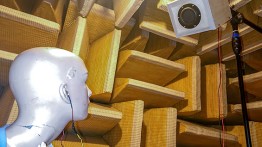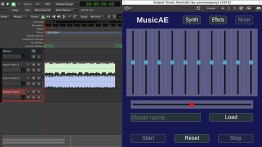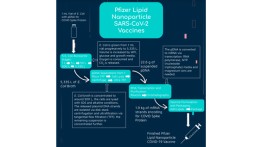Senior Snapshots: Engineering 2021
POSTED ON: May 21, 2021
This year we spoke to graduating seniors Bibi Razak, Michael Chan, Miho Takeuchi, Sam Maltz, and Hyomin (Flora) Seo about their paths through the Albert Nerken School of Engineering. While some have been coming to campus to make use of labs and work on projects, they've been largely remote through their final semester. We asked the seniors to discuss their academic experiences and reflect on their time at Cooper.
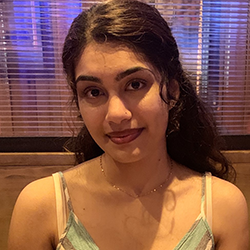 One benefit of attending Cooper for Bibi Razak was, prior to the pandemic, getting to see her favorite New York City bridge—the Verrazzano—while commuting each morning on the Staten Island ferry. Born in Guyana, the civil engineering senior grew up on Staten Island and says the urban environment made a strong impression on her at an early age. “It was a humbling experience being a small girl and looking up and seeing this huge skyline,” she recalls. “The buildings and the bridges and the city were what inspired me to go into civil engineering.”
One benefit of attending Cooper for Bibi Razak was, prior to the pandemic, getting to see her favorite New York City bridge—the Verrazzano—while commuting each morning on the Staten Island ferry. Born in Guyana, the civil engineering senior grew up on Staten Island and says the urban environment made a strong impression on her at an early age. “It was a humbling experience being a small girl and looking up and seeing this huge skyline,” she recalls. “The buildings and the bridges and the city were what inspired me to go into civil engineering.”
She credits her dad as another source of inspiration. “He’s not an engineer,” she explains. “He’s a handyman, but that’s because where we lived in Guyana there wasn’t really a formal education system. If you were an engineer, you engineered and you didn’t have a degree to prove it. So, my dad was an engineer there, but then he moved here… and he’s a handyman.” Bibi remembers spending much of her youth watching him work on projects around the house. “My mom would say she wants a wall opened up or the kitchen redone. He would be the guy who did it all, and I would be next to him, seeing what he did. I knew I wanted to do something like that when I got older.” While attending Staten Island Technical High School, her curiosity blossomed into a passion for physics and an affinity for solving difficult problems.
In fact, when we spoke to Bibi as an incoming student four years ago, the thing she was most excited about was taking really challenging math and science courses. Asked now whether Cooper has satisfied that craving, she jokes, “A little too much in some cases.” Engineering Thermodynamics with Professor Martin Lawless was a particularly difficult course, she says, but it also ended up being one of the most rewarding. “I think almost all of my classes were a challenge. And when you have a number of difficult classes and you’re trying to study for all of them, it’s very difficult, but it’s worth it in the end. I love challenges for the end moment when you complete it and get that sense of accomplishment. Cooper definitely lived up to that.”
For her senior project, she and two teammates designed a multi-use high-rise in Hudson Yards: “We chose this building because it would be a difficult structural system to design. We really focused on the structural subframe and making sure all of the columns, beams, and slabs would be able to withstand the live loads and the weight of the building itself.” Their design is based on the specifications of an actual building site in Hudson Yards, which the team visited in person last September to take pictures and calculate dimensions.
“I think my favorite thing about designing the structural part was actually the foundations,” she says. “It was really interesting because we had to get the sub-surface profile data for the soil, then we had to take that information, filter whatever we needed out of it to find the bearing capacity of the soil, then we were able to design our piles for a deep foundation and we made the drawings for it. When you see the finished drawing of what you designed, it’s such a good feeling.”
Bibi is currently interning at ConEdison. In July, she plans on taking the Fundamentals of Engineering (FE) exam, which is the first step after college for getting licensed as a civil engineer. But for now, she’s finding time to relax after a demanding year and hopes to make time to go on a trip with a group of civil engineering classmates this summer. “I didn’t realize how much I was going to learn from other students,” she says, reflecting on what she’ll miss most. “Everybody at Cooper is brilliant, from the teachers to just about anybody at the school. You speak to them and realize they have so much to offer in terms of intelligence and perspective. It doesn’t have to be about engineering, just life in general. The people at Cooper are amazing.”
Looking back at her incoming student profile from 2017, Bibi also has some words of wisdom she would give to her first-year self: “Don’t procrastinate and don’t underestimate Cooper. High school was very straightforward. You were able to pull things off at the last minute. It’s not how it works at Cooper. If I could give any advice, it would be don’t procrastinate. Schedule your time, get organized, and you will succeed.”
 For a chemical engineering major, Michael Chan spends a surprising amount of time building things. “I have a 3D printer. I’m actually printing something right now,” he says over a video call from his home in Queens. “It’s an enclosure for some LEDs to make a battery-powered light. I’ve always liked electronics. I mainly build electronics because I can’t do much with chemical engineering at home, since the equipment is too big, so I’ll build things like microcontroller circuits.”
For a chemical engineering major, Michael Chan spends a surprising amount of time building things. “I have a 3D printer. I’m actually printing something right now,” he says over a video call from his home in Queens. “It’s an enclosure for some LEDs to make a battery-powered light. I’ve always liked electronics. I mainly build electronics because I can’t do much with chemical engineering at home, since the equipment is too big, so I’ll build things like microcontroller circuits.”
A New York-native and graduate of Saint Francis Preparatory School, Michael applied to The Cooper Union on a whim at the recommendation of his high school guidance counselor. “I didn’t think I’d get in because it’s such a competitive school,” he recalls. But it was the close-knit community and potential for exploring his interests in the labs and shops that really excited him. “I’ve always been interested in chemistry, though I had no idea what I wanted to do with it. At Cooper I actually gravitated more towards working with mechanical engineers in the shop. My parents wondered if I was going to switch majors.”
His time in the shop included one particularly notable, record-breaking project. Michael and his classmate Chris Mignano, a mechanical engineering major, along with others worked together on creating the Cooper Cube, the world’s largest functioning Rubik’s cube. Weighing approximately 800 pounds, it features massive six-foot faces that can be manipulated thanks to a system of rollers on fiberglass tracks. The project was conceived in Professor Eric Lima’s Principles of Design course as a challenge to “break the internet”—to create a spectacular, monumental tribute to the incredible things Cooper students can accomplish.
Michael’s senior design project in chemical engineering is also quintessentially Cooper, both in its outsized ambition and its social relevance. Each year, chem-e seniors are challenged to collaborate on planning and designing some variety of plant—a production facility that uses chemical processes on a large scale. This year, students were tasked with designing ways of manufacturing different types of COVID-19 vaccines nearly in-step with the government rollout. Michael’s group was assigned the Pfizer–BioNTech mRNA vaccine and their project, which details the entire production process from lab culture to the final end product of millions of vaccines, required keeping abreast of research developments in real-time, as they were published.
“It’s been difficult because we have limited information, or often contradictory information,” he explains. “A lot of scientists and engineers don’t agree on certain things, and we can’t get access to actual Pfizer or Moderna information because it’s proprietary.” The experience has given him a much deeper appreciation of the difficulties involved in scaling up the vaccine production in the midst of the pandemic. “Knowing so much more about it now, including the actual mechanisms of how the vaccine works in the body and how to produce it, I’m just like, how are they even doing this? Even with the small amount of understanding we gained, it’s amazing how they’re actually doing it this quickly.”
The centrality of chemistry to so much of modern life has been a big draw for Michael. “Everything can be traced back to chemistry in one way or another,” he says. “You can go in so many different directions with it, working in energy, medicine, or what I’m going into now, semiconductors.” Shortly after graduation, he plans on starting a job as a process engineer at a company that designs and manufactures semiconductor processing equipment for the fabrication of integrated circuits. “I’m nervous and excited,” he says. “I’ll be working on plasma-enhanced chemical vapor deposition. It’s a step in the chipmaking process where they take the silicon substrate and then deposit metal in very thin layers to form the wires for the circuits. It’ll be a lot of lab work. I’ll have to wear the complete cleanroom suit.”
The idea of working in semiconductors is attractive in part because it combines two aspects of engineering he enjoys most. “It’s a complete fusion of electronics and chemistry, literally at an atomic level. So yeah, that seems like a pretty good field for me.”
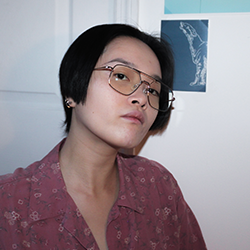 When Miho Takeuchi spoke to us four years ago, she was eager to enjoy all the East Village had to offer—its independent record stores and live music scene most of all. Born in Japan, Miho grew up in Shanghai, and her love of music and penchant for tinkering with hi-fidelity audio equipment brought her to Cooper to study acoustics. Looking back, the mechanical engineering senior sees her academic journey as marrying the creative and technical sides of her passions.
When Miho Takeuchi spoke to us four years ago, she was eager to enjoy all the East Village had to offer—its independent record stores and live music scene most of all. Born in Japan, Miho grew up in Shanghai, and her love of music and penchant for tinkering with hi-fidelity audio equipment brought her to Cooper to study acoustics. Looking back, the mechanical engineering senior sees her academic journey as marrying the creative and technical sides of her passions.
“I was definitely a STEM kid, but I also really liked the arts,” she says over a video call, a bass guitar leaning against the wall behind her. “My interest in music influenced me to go into something related to audio and science, but something where I could still get in touch with my artistic roots. I grew up playing the violin and that became a steppingstone for me to figure out this world of acoustics.” She remembers her excitement at first learning about Cooper’s anechoic chamber and acoustics lab. “While I was visiting Cooper during my junior year of high school, I thought the facilities were really cool, and because it’s such a small school I was impressed by how easy it would be to use them and to work closely with professors.”
One of her more memorable projects came during Professor Martin Lawless’s Sound and Space course, which focused on the subdiscipline of architectural acoustics and how sound interacts with built environments. “Coincidentally around that time I was working with an architecture student on a design competition hosted by the Acoustical Society of America,” Miho says. “The prompt was to design a summer music pavilion for an urban orchestra.” Given a landscape map and a set of parameters detailing everything from the venue’s proximity to noisy highways to its audience size to the styles of music it would host, Miho and her collaborator designed a rendering of what the concert space would look like and how it would perform. “That basically became my final project for the class,” she says. “It was definitely an eye-opening experience. That was my first time working with an architect. The amount of data I got to play around with and seeing how intricate shapes move sound around was something I really enjoyed.”
Her senior project, which she worked on with mechanical engineering classmates Evan Bubniak and Daniel Pak, explores a different kind of sound space. “Basically, it’s about improving the personalized experience of how we listen to immersive audio in virtual reality,” she explains. When we hear sound, our brains automatically locate its spatial origin in relation to our bodies. Precisely recreating that effect via stereo headphones usually requires an extensive process of testing and data collection to create a profile of individual listeners. The group’s project aims to develop a faster and less extensive process: “We’re trying to get data about individuals’ ears by taking fewer measurements and extrapolating from a machine learning model trained on an existing database of the way people hear surround sound.”
Though she tends to approach sound from a technical perspective, Miho has also broadened her relationship to music. “New York definitely opened me up to a big area of independent music and more experimental aspects of music, whereas I grew up playing mostly in a classical tradition. That influenced me to pick up the bass.” Going to concerts around the city had been a particularly important part of her life at Cooper prior to the pandemic. “Not being able to do that for the past year was really painful for me.”
In the fall, Miho will pursue a master’s in engineering acoustics at the Technical University of Denmark. “My favorite job would be to work as an acoustic consultant because of the different disciplines of people involved,” she says. “I had interned previously at an engineering firm, and I really enjoyed talking to the people who work in construction, civil engineers, electricians. Oh, and interior designers. They are mind-blowingly creative. And then there are people working on the HVAC systems, and I get to look at how that interferes with acoustics. There are lighting consultants who focus on the color and warmth of a space. Seeing all of that come together is very pleasing.” She hopes to be able to continue that kind of collaborative work in her career. “Knowing that something like a really grandiose hotel lobby or concert space is backed by all these disciplines and people working together, I find that really beautiful.”
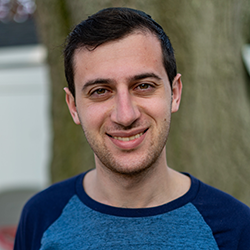 Sam Maltz chose to study electrical engineering at Cooper because it seemed a practical extension of his more abstract, mathematical side: “If you would have asked me five years ago what I would major in, I probably would’ve said math.” A native of South Brooklyn, Sam attended a small Jewish high school on Long Island. “I really enjoyed math and science,” he says. “But because the school was so small, there weren’t many specialized courses. An engineering course happened to open up, and that was really interesting and showed me how I could apply math and science. It influenced me to look into engineering.”
Sam Maltz chose to study electrical engineering at Cooper because it seemed a practical extension of his more abstract, mathematical side: “If you would have asked me five years ago what I would major in, I probably would’ve said math.” A native of South Brooklyn, Sam attended a small Jewish high school on Long Island. “I really enjoyed math and science,” he says. “But because the school was so small, there weren’t many specialized courses. An engineering course happened to open up, and that was really interesting and showed me how I could apply math and science. It influenced me to look into engineering.”
Another influence was his family. “My mom, when she was younger, was thinking about going to Cooper. She ended up not going into engineering, but it definitely put Cooper on the radar for me,” he says. “And my grandfather was an electrical engineer, so he influenced me as well.” Sam was also attracted to Cooper’s intimate learning environment: “It felt like the best option for me coming from a small high school. I liked the idea of having a community where you would be able to get the personalized attention from professors and be able to ask questions whenever you wanted to. So that really appealed to me.”
His initial foray into project-based learning came during the first-year Digital Logic Design course. “It really throws you into the deep end and shows you what you’re capable of,” he says. “There are plenty of times working on the final project at the end of the semester where you think, how will I ever be able to finish this? Is this even possible? You really just have to believe in your abilities and realize you’re capable of doing this stuff. You’re in Cooper now. You can do it. That was a great experience for me.” Four years later, he feels that electrical engineering was a good choice for indulging his passion for math. “It really is very math heavy, and I really enjoyed that. I’m minoring in math, and almost all of my electives have been math courses.”
For his senior project, he and two classmates worked under the advisement of Professor Samuel Keene on continuing a musical machine learning project first conceived by Joseph Colonel, a Cooper alumnus and PhD candidate in the Centre for Digital Music at Queen Mary University of London. Colonel developed a deep neural network model, called an autoencoder, that can be used to smoothly interpolate between mixed audio tracks. “This issue is that it’s not that usable for most musicians who use digital audio workstations, since it wasn’t the best format for that,” explains Sam. So, the team set out to extend Colonel’s work by creating MusicAE, an enhanced plug-in version of the technology that would more readily suit the workflow and creative process of musicians.
Although Sam has been taking courses remotely from his home in Brooklyn, he and his teammates were adamant about collaborating on the project in-person. “We thought it was important that we have the senior year experience, so we actually made an effort to all come into school every week. That was nice.” He’s also recently began working on a research project led by Professor Fred Fontaine and facilitated through the Small Business Technology Transfer program (STTR), which supports government research partnerships between private firms and nonprofit research institutions. “It’s with a company called MaXentric Technologies in conjunction with the U.S. Air Force,” says Sam. “What we’ve been doing is using machine learning to classify wireless signals. It’s been a great experience introducing me to the world of research.”
Asked what’s next for him, Sam says he’s “doing Cooper after Cooper.” He began taking credits towards a master’s in electrical engineering from Cooper two years ago, concurrent with his undergraduate coursework, and hopes to finish the program next year. “After that, I’m still not a hundred percent sure. Maybe I’ll go for a Ph.D. in the future.”
 Hyomin (Flora) Seo arrived at Cooper with a desire to make a difference. Born in Seoul, she attended high school in the U.S. but spent summers back in South Korea visiting her family and volunteering at a school for students with autism. “I worked as a summer semester teacher for students who could not be left home alone, and I couldn't really communicate with them because holding their attention was extremely challenging,” she says. “So, I developed a simple track and draw app that they loved interacting with. That was a small success. Through that, I learned that even the most straightforward technology could really help people, and I loved that feeling. It became a strong motivation for me.”
Hyomin (Flora) Seo arrived at Cooper with a desire to make a difference. Born in Seoul, she attended high school in the U.S. but spent summers back in South Korea visiting her family and volunteering at a school for students with autism. “I worked as a summer semester teacher for students who could not be left home alone, and I couldn't really communicate with them because holding their attention was extremely challenging,” she says. “So, I developed a simple track and draw app that they loved interacting with. That was a small success. Through that, I learned that even the most straightforward technology could really help people, and I loved that feeling. It became a strong motivation for me.”
The Cooper Union seemed like a natural fit for that motivation. “I got inspired by Cooper,” she says, noting that she also felt drawn to the founding belief that education should be “as free as air and water.” Competitiveness was also a factor. “The significant scholarship amount that Cooper presents to every admitted student means that they only admit the best among everyone during the admissions process, so the result of the screening is a collection of the most intelligent and motivated engineers.” The general engineering major stood out to her in particular because it offered the most flexibility for exploring different courses and disciplines. “That characteristic actually worked out the best for me,” she says. “My experience at Cooper was colorful. I really took advantage of the freedom that the BSE gives you.”
Early on, her interests skewed towards mechanical engineering: “I was fascinated with the Formula SAE motorsports team. I became a leader of one of the subsystem teams, Powertrain A, and we all traveled to Michigan to race. That was one of my favorite experiences I’ve had at Cooper.” For the first two years, taking mechanical engineering courses and working on the formula team helped Hyomin develop her mechanical design and modeling skills. “But I still had a thirst for other fields,” she says.
“My dad is a surgeon, so neuroscience and biomedical engineering came to me as a big interest.” At the end of sophomore year, she enrolled in a summer semester course on neuroscience and neuromodulation at Korea University. “As I was doing that, I also learned about computer science and how machine leaning is used in neurology and bioengineering. That was eye-opening to me. So instead of pursuing mechanical engineer, I worked on getting a computer science minor for the last year and a half. All of this diversity, with mechanical engineering, computer science, and neurology, came together. And that’s how I ultimately shaped not only my senior project but also my academic path and my goals.”
Under the guidance of Professor Eric Lima and Professor Carl Sable, she and a team of four other Cooper students collaborated with Mount Sinai BioDesign and the Department of Neurosurgery at Mount Sinai on their senior project, NINS: Non-Invasive Intranasal Neuromodulation System. “We built a neuromodulation device for acute ischemic stroke patients,” explains Hyomin. The details of their design cannot be publicized due to a confidentiality agreement, but the goal was to prototype a method of using electric stimulation to increase collateral blood flow in the brain as a way of extending the window of treatment. Because of the pandemic, Hyomin worked on the project virtually, completing her final year at Cooper remotely from Seoul.
“It was a significant time difference,” she says. “But I managed to work closely with the Mount Sinai BioDesign team and my classmates, Jared Lam, Jacques Mosseri, Ruben Solano, and Brian DeHority. They all live in New York and worked really hard both at Cooper and at Mount Sinai’s lab building a physical prototype. The project will be ongoing even after we graduate. The goal is to test it and ultimately get it approved by the FDA and actually have it on the market in hospitals, saving the lives of stroke patients.”
Hyomin will travel back to New York in June to start an internship in the AI department of Mount Sinai BioDesign. Following that, she’ll start working towards her master’s in biomedical data science at the Icahn School of Medicine. “There are a lot of exciting fields in medicine and technology that I can dive into, such as surgical devices or AI, medical imaging, brain monitoring… I'm just looking forward to exploring all of that.” She’s hoping her return to New York will offer the chance to catch up with some classmates she missed saying goodbye to in person.
“Cooper is amazing in the sense that I've never been in a building that is so dense with such smart and dedicated people,” she says. “Every week at Cooper is a crunch week. So, after four years of crunching together, I'm now hearing that so many of my classmates have found their places in industry—considerable places—it's very impressive. I'm definitely going to miss being among them. I'm not exaggerating when I say that I’m sure this handful of people are literally going to change the landscape of science and engineering.”

